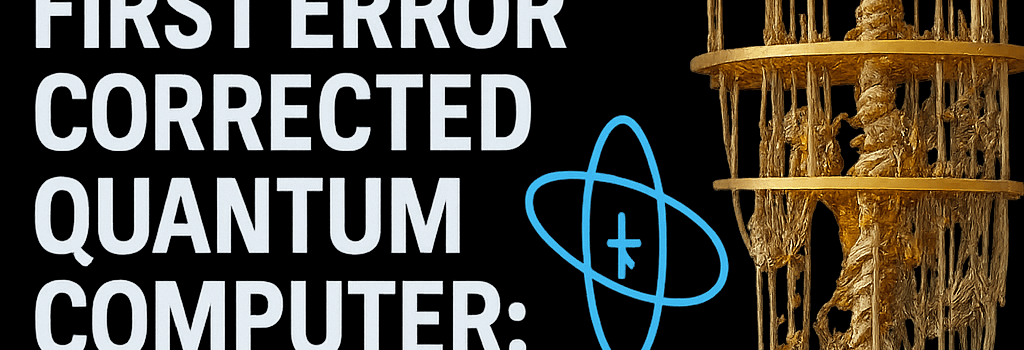IBM Introduces First Error-Corrected Quantum Computer: Starling

A Four-Year Roadmap to Error-Corrected Quantum Advantage
On June 10, 2025, IBM published a granular, four-year development plan for Starling, its first fully error-corrected quantum compute system. Scheduled for deployment in 2029, Starling is designed to execute 100 million logical operations without uncorrected error across 200 logical qubits—an inflection point that should put it beyond the reach of classical simulation.
The timeline breaks down as follows:
- 2025: Release of Nighthawk and Loon test chips.
- 2026: Kookaburra stable-memory processor with 12 logical qubits.
- 2027: Cockatoo functional compute unit, enabling multi-chip logical scaling.
- 2028–2029: Initial Starling prototypes transitioning to production environment.
“We’ve answered the science questions on error correction—it’s now an engineering challenge,” says Jay Gambetta, IBM Fellow and VP of Quantum Hardware.
Advancing Quantum Error Correction: From Heavy Hex to LDPC Codes
IBM’s superconducting qubit platform historically used a “heavy hex” lattice to minimize crosstalk at the cost of restricting error-correction codes. To support a low-density parity-check (LDPC) code—more hardware-efficient for logical qubit protection—IBM has innovated in two domains:
- Multi-layer chip packaging: Incorporating superconducting through-silicon vias and three wiring layers to implement nearest-neighbor and long-range couplers on a planar chip.
- Crosstalk suppression: Transitioning to a dense square lattice (the Nighthawk family) with interleaved ground planes and tunable resonator filters to drive measured crosstalk below 1×10–4.
These advances underpin the development of Loon—a high-connectivity processor due for release in late 2025—and Nighthawk, a user-facing 120-qubit device optimized for iterative experimentation.
Developmental Processor Roadmap: Nighthawk, Loon, Kookaburra, Cockatoo
- Nighthawk (2025–2028): Annual upgrades boosting logical gate operations from 5,000 to 15,000. 2026 sees three chips chained (360 qubits); 2027 scales to nine (1,080 qubits).
- Loon (Q4 2025): Demonstration of multi-layer packaging: high connectivity, long-range couplers, and vertical interconnects in a single chip.
- Kookaburra (2026): 144-qubit, distance-12 bivariate bicycle LDPC code hosting 12 logical qubits for stable memory. Alternative 288-qubit, distance-18 configuration also validated.
- Cockatoo (2027): Functional compute unit combining Kookaburra memory modules with magic-state injection qubits and on-chip universal bridge for multi-chip entanglement.
Performance Benchmarks and Targeted Use Cases
With single- and two-qubit gate fidelities exceeding 99.96% and a syndrome-measurement latency under 1 µs, Starling’s logical clock cycle is projected at 10 µs. Benchmark algorithms include:
- Quantum Approximate Optimization (QAOA): Portfolio optimization at N=200 variables.
- Variational Quantum Eigensolver (VQE): Simulating transition metal catalysts with 150 electrons.
- Quantum Fourier Transform (QFT): Subroutines for prospective cryptanalysis research.
Scalability and Engineering Challenges
Starling’s architecture consists of modular dilution refrigerators interconnected by a Universal Bridge—one microwave waveguide per code distance—for coherent coupling. Key engineering elements include:
- Cold CMOS control electronics: Custom custom ASICs operating at 4 K to minimize cabling and reduce thermal load.
- Real-time FPGA decoders: IBM’s message-passing decoder distributes syndrome extraction across parallel FPGA clusters, ensuring latency under 10 µs even at 200 logical qubits.
- Thermal and vibrational isolation: Active vibration damping and multi-stage thermal anchoring to preserve qubit coherence above 100 µs.
Expert Perspectives and Industry Impact
According to Dr. Sarah Sheldon (MIT Lincoln Laboratory): “IBM’s move from qubit counts to functional compute units aligns with the broader trend of integrating quantum processors into classical supercomputing environments.”
Comparatively, Google’s Sycamore remains at the NISQ scale (~54 qubits), while IonQ and Quantinuum pursue trapped-ion error correction with 32–64 logical qubits in roadmap. IBM’s modular approach may accelerate enterprise adoption via hybrid cloud platforms.
Future Outlook: Blue Jay and Beyond
Beyond Starling, IBM’s Blue Jay system—targeted for 2033—aims for 2,000 logical qubits. This milestone could enable full Shor’s algorithm on 4,096-bit keys, representing a quantum-breakthrough in cryptanalysis. Meanwhile, IBM continues to refine qubit coherence (T1 > 200 µs), gate fidelity (99.99%), and packaging density to power the next generational leap.
Additional Section: Integration with Cloud and AI Workflows
Starling will integrate into IBM’s Quantum Cloud infrastructure, providing RESTful APIs, Quantum Volume tracking, and hybrid workflows with IBM Watson AI accelerators. OpenQASM 3.0 support and cross-platform SDKs ensure interoperability with Qiskit, Cirq, and Pennylane.
Additional Section: Supply Chain and Fabrication Advances
IBM’s chip foundry collaborations have yielded new superconducting metal alloys (NbTiN) and ultra-low-loss dielectrics. Advanced ultraviolet lithography achieves 45 nm linewidths, enabling qubit footprints under 100 µm2. Cryogenic packaging leverages indium bump-bond arrays for 1,000+ I/O channels per chip.
Additional Section: Strategic Partnerships and Ecosystem Development
IBM has signed alliances with Oak Ridge National Laboratory for co-developing error-correction software stacks, and with GlobalFoundries for high-volume superconducting wafer production. An open ecosystem encourages third-party development of quantum algorithms in finance, materials science, and logistics.